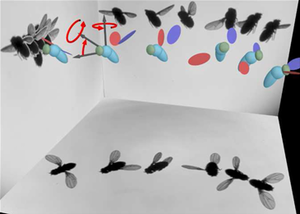In the trenchesUSAF looking to emulate fruit-flies for killer insect swarm drones
The U.S. Air Force is studying how fruit flies maneuver within a heavily instrumented “simulation tunnel” in order to develop tiny, potentially lethal insect-sized flying robots; tiny military swarm droids could scatter across towns or cities to locate or spy on persons of interest to the U.S. military; they might even be able to land on the back of someone’s neck and blow his head off using some kind of tiny warhead

Fruit fly flight kinematics captured // Source: technologyreview.com
The U.S. Air Force is researching how fruit flies maneuver within a heavily instrumented “simulation tunnel” in order to develop tiny, potentially lethal insect-sized flying robots.
According to a statement issued the other day by the Air Force Office of Scientific Research (AFOSR), research underway at in Californian labs will teach military designers how to build tiny robot aircraft which can fly around indoors or in built-up areas the way flies do.
“This work investigates sensory-motor feedback mechanisms in the insect brain that could inspire new approaches to flight stabilization and navigation in future insect-sized vehicles for the military,” said Dr. Willard Larkin of AFOSR.
Dr. Andrew Straw of Caltech, leading the project for the Air Force, has built a special arena for his test flies to aviate around in, with video walls allowing a simulated environment to be presented to the fly. The insect test subject is tracked using a cunning multi-camera system.
“We developed a 3D fly tracking system which was our most significant technical challenge: localizing a fly in 3D nearly instantaneously,” says Straw. “Next, we developed visual stimulus software capable of making use of this information to project virtual edges and textured floors in which we could modify the fly’s sensory-motor feedback mechanism.”
According to the AFOSR:
The scientists have found that, counter to earlier studies suggesting that insects adjust their height by measuring the motion beneath them as they fly, flies in fact follow horizontal edges of objects to regulate altitude. Remarkably, this edge following behavior is very similar to a rule they use for steering left and right and always turning towards vertical edges.
Lewis Page writes that if Straw and his colleagues can work out the rules the flies use to navigate — thought to be primarily visually based — it could be possible to design control systems for so-called Micro Air Vehicles (MAVs, small robot aircraft already in development) which would let them maneuver in places where there is no GPS signal.
Tiny military swarm droids could scatter across towns or cities to locate or spy on persons of interest to the U.S. military. They might even, as shown in this YouTube video, be able to land on the back of someone’s neck and blow his head off using some kind of tiny warhead.
